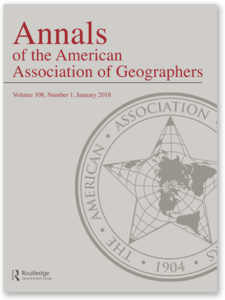Read the Journal
Latest Articles
Submit to this journal

One of the world’s leading geography journals since 1911, AAG’s flagship publication publishes original, timely, and innovative articles that advance geographic knowledge in all facets of the discipline. Articles adhere to a high standard of scholarship and make an important contribution to geographic knowledge. They are grounded in the relevant literature of the specialization it represents and, where appropriate, establish relationships to themes within the broader discipline. Journal articles span across but are not limited to Geographic Methods; Human Geography; Nature and Society; and Physical Geography, Earth and Environmental Sciences. Published 10 times a year, one special issue is dedicated to a single theme drawing on a diversity of papers from across the discipline.
Impact Factor: 3.2, ranking 21st out of 171 geography journals worldwide
Chrome is the recommended browser to access journal articles, as Firefox is currently not working.
Read the Journal- Thinking Through Urban Fragments: The Making of the Millennium City of Gurgaon, India
- Diagnosing Spatial and Temporal Biases of OSM Contributors: Identifying Differences Between Gender and Age from an Online Survey
- Urban Green Technology Innovation: The Spillover Effects of a Low-Carbon City Pilot Program
- Cracking Appalachia: A Political-Industrial Ecology Perspective
- Spaces of Learning: Pedagogy and Movement Building Within the Black Panther Party
- Infrastructuring Mobility via State-Led School Franchising: Leveraging Public Educational Resources to Facilitate Middle-Class Residential (Im) Mobility
- Identifying Rich Clubs in Spatiotemporal Interaction Networks
- Measuring Temporal Evolution of Nationwide Urban Physical Disorder: An Approach Combining Time-Series Street View Imagery with Deep Learning
- Integrating People in Place-Based Accessibility Measures: Design and Application of a Mode Choice Accessibility Model
- Unveiling Disparities in Bicycling Mobility Patterns Across Socioeconomic Statuses: A Framework for Identifying User Profiles in Dockless Bike-Sharing Systems
- Global Geographies of Weather Modification in an Era of Climate Change
- From Securing the Border to Securing Nature: Homeland Security as an Emerging Environmental Actor in the U.S.–Mexico Borderlands
- The Great Death Valley National Monument Mission 66 Conspiracy (That Never Was)
- Reimagining National Parks for the Twenty-First Century: Lessons from Yosemite’s Past
- Nine Processes That Have Shaped the U.S. National Park System
- Rethinking Indigenous Hunting in National Parks
- Regional Relevance of a Cultural Park: Leverage Points Identified Through Spatial-Social Network Analysis
- Representing Organ Mountains-Desert Peaks National Monument: Encounters with a U.S. Public Lands Artist-in-Residence Program
- Identification of High Fire Potential and High-Use Spatial Intersections at a National Forest to Understand Recreation Displacement Related to Wildfire Events
- Managing the Imagined Spatialities of Protected Sites: (Un)Bounding Industrial World Heritage via Mental Maps
- Vegan Geographies: Negotiations, Contestations, and Encounters in the Everyday Spaces of Veganism
- Commodification in Disguise: Growth Dynamics and Emerging Geography of Culture-Led Urban Redevelopments in Contemporary China
- Introducing Jurisdiction
- Protected Areas on an Amazon Frontier: Payments for Environmental Services and the Future of Extractive Reserves in the Terra da Meio
- Black Self-Defense as Social Reproduction: Geographies of Insurgency and Counterinsurgency Amidst Racialized Uneven Development in Atlanta
- Story Mapping Praxis to Principles: Learning from the Atlascine Project
- Revisiting the Uncertain Geographic Context Problem: Expanding Its Scope to Include Indoor Geographic Contexts and Dynamics in Environmental Health and Social Science Research
- Urban Sprawl and Subjective Well-Being: U.S. County-Level Evidence
- Disaster Risk Reduction and the Cuban Exception: Infrastructural and Ideological Power after Hurricane Flora (1963)
- Nexus Between Exposure to Natural Outdoor Environments and Cognitive Competence among Older Adults in China
- A Reciprocal Statistic for Detecting the Full Range of Local Patterns of Bivariate Spatial Association
- Inheriting Racial Privilege and Oppression Through Proximity: Evidence from the Everyday Lives of Mixed-Race Couples in Australia
- More-Than-Rebel Territory: War, Resistance, and Relations in the Salween Peace Park
- Reframing the Dualistic Nature of Ride-Hailing for Women: Empowerment Versus Adaptive Preferences
- A Big “X” in the Open Wound: A Queer and Decolonial Borderlands Tale of the Chamizal Parklands
- Maximizing Finance for Sustainable Development? Microfinance, Debt-Driven Deforestation, and the Self-Regulation of Environmental Harm
- An Efficient Approach for Solving Hub Location Problems Using Network Autocorrelation Structures
- On the Example: The Need for a Complementary Contraposition to Giorgio Agamben’s Theorization of the Exception
- Toward a Humanitarian Geographic Information Science (HGISci): Principles and Applications
- America the Beautiful: Meeting “30 × 30” Conservation Goals Through Connected Protected Areas
- Decoupling and Decomposition of Emissions and Economic Growth Based on Interprovincial Embodied Carbon Flow in China
Manuscripts
Submission:
Manuscripts should be submitted electronically through ScholarOne Manuscripts. For detailed instructions about article submission see:
The Annals publishes papers in four categories: Regular Manuscripts, Special Issues, Forums, and Commentaries. The journal also publishes the AAG Presidential Address and memorials for former AAG Presidents and distinguished geographers.
- Regular Manuscripts—Articles submitted for publication should be original, timely, innovative, and advance knowledge in all facets of the discipline. They should address significant research problems and issues, and be attuned to the sensibilities of a diverse scholarly audience. Articles should be a maximum of 11,000 words, including abstract, references, notes, tables, and figure captions.
- Special Issues—Special Issues are curated by Editors and include a collection of shorter manuscripts (around 5000 words) about a specific theme or issue. Topics rotate across the areas covered by the Annals; each year there is one Special Issue that highlights the work of geographers on a significant global theme. Abstracts of potential articles will be solicited via an open call. The articles are by invitation only, led by an Annals Editor, and based on the evaluation of the abstracts.
- Forums—Forums are a collection of short papers on a focused topic that are published together in the journal. Forums are an opportunity to showcase and advance significant intellectual insights in the discipline in a coherent and collective way. Forums consist of an introduction (2,500 words) and short individual papers (5,000 words each), with a maximum total word limit of 25,000. A forum is proposed by a forum organizer, and if accepted, the forum organizer works in tandem with an Editor to guide the papers through the peer review process. Forum proposals should provide a background and context, table of contents, timeline, and justification of the forum’s significance and relevance to the Annals audience.
- Commentaries—Commentaries are responses to specific published Annals articles and appear in online form only. They should be submitted within one year of the publication of the original article and written in a style and tone that is professional, scholarly and concise (less than 2,000 words including references). Commentaries will be peer reviewed. Authors of the original article will be invited to respond to the commentary in a short endorsement and/or rebuttal. To submit a commentary, please see the commentary submission guidelines linked above.






